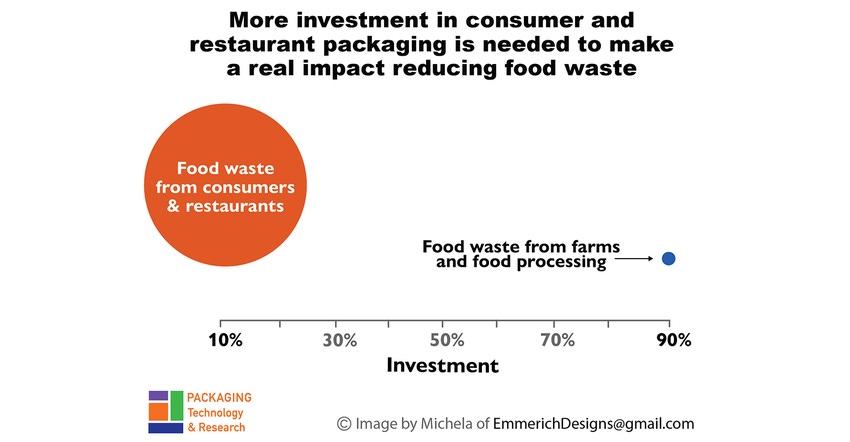Packaging Can Solve Our Food Waste Conundrum
There’s one area where we can lessen the environmental impact of food waste by 80%.
April 28, 2021
Earth Day brought up renewed interest in the environment and the US goal to halve greenhouse gas (GHG) emissions by 2030. Not surprisingly, there are a flock of upcoming conferences on food waste reduction.
What’s the connection between food waste reduction, Earth Day, and the environment?
Food waste is responsible for more GHG emissions than the combined emissions from the transportation and electricity sectors in the US.
If food waste were a country, it would be behind the US and China in responsibility for GHG emissions, ranking 3rd on the list of sources.
At these conferences, potential solution providers and investors essentially "speed date". The critical screening question asked is, “Where and how much food waste are reduced by this solution?”
This question is most important because where food waste happens determines who benefits when food waste is reduced. This differentiation has governed investment and progress in food waste reduction efforts substantially. From farm to retailer, investment has produced results in both food waste reduction and profits. For example, in food waste reduction...
From farm to food processor means farmers can then sell more viable crops to food processors;
At retail benefits the retailer and the brand that may get billed back for less product that’s unsaleable;
Within a food processing facility results in value from upcycled food versus paying disposal costs.
This food waste reduction is all good news! It’s evidence that investments in science and engineering can provide results. Interestingly 90% of investment dollars have flowed into reducing food waste from farm to retailer, although only 20% of the environmental impact of food waste occurs in this entire area of the supply chain. While this does vary by food category, season, retailer, and brand, the ratio is startling.
The fact is reducing consumer-derived food waste has the largest impact on the environment. This is because by the time food gets to the consumer, resources that grow, process, package, and transport food to the consumer have been expended. We can lessen the impact of food on the environment by zeroing in on this one area and impact 80% environmental impact of food waste. Reducing consumer-derived food waste is a challenge and a unique opportunity for packaging!
Outdated logic is: If consumers waste less food, this results in lower food sales as the food system becomes more efficient. Today’s facts are clear in that brands and retailers realize that:
Market share can be gained: Brands realize that offering consumers an opportunity to reduce their food waste is a powerful means to connect packaging to a reduced environmental impact. We have seen then when consumers buy higher MPG cars to reduce the amount of money they spend on gas.
Strategic goals can be met: For brands and retailers to meet their and UN, EPA, FDA, and USDA commitments of 50% by 2030 to reduce food waste, consumer-derived food waste must be tackled.
Innovation partners can better align: Addressing consumer-derived food waste aligns forward-thinking companies in the value chain, and these are beneficial partnerships.
Top investors – the Rockefeller and Pisces Foundations – are leading the charge. This is a tremendous opportunity for packaging to gain investment dollars, add meaningful value to consumers, and move the dial on the environment.
We can all do our part! Personally, I am making sure investments in packaging and food waste reduction align with my clients’ food waste reduction and business goals. I have blended science and consumer insights to help my food manufacturing clients:
Find the opportunity — what product has the most potential to reduce consumer food waste;
Define the packaging solutions — isolating the best packaging solutions;
Ensure communication resonates with consumers.
Notably, today is International Stop Food Waste Day. Please join me in asking the question, “How much does this solution reduce consumer food waste?” Together, we can use packaging to address the Food Waste Conundrum.
See you at the conferences!
References:
ReFED, 2018 US Food Waste Investment Report
EPA. 2020. Inventory of U.S. Greenhouse Gas Emissions and Sinks: 1990–2018
Want to know more about packaging technologies that can food waste? Listen to the Packaging Possibilities: Food Waste Reduction Breakthroughs podcast posted May 12 in which Sand identifies an assortment of novel packaging-driven options, including smart tags and printed sensors.
Claire Sand, PhD, has 30+ years of experience in industry and academia. She's owner of Packaging Technology and Research and Gazelle Mobile Packaging and is an Adjunct Professor, CalPoly, Michigan State University, and the University of Minnesota. Her email is [email protected]
About the Author(s)
You May Also Like





